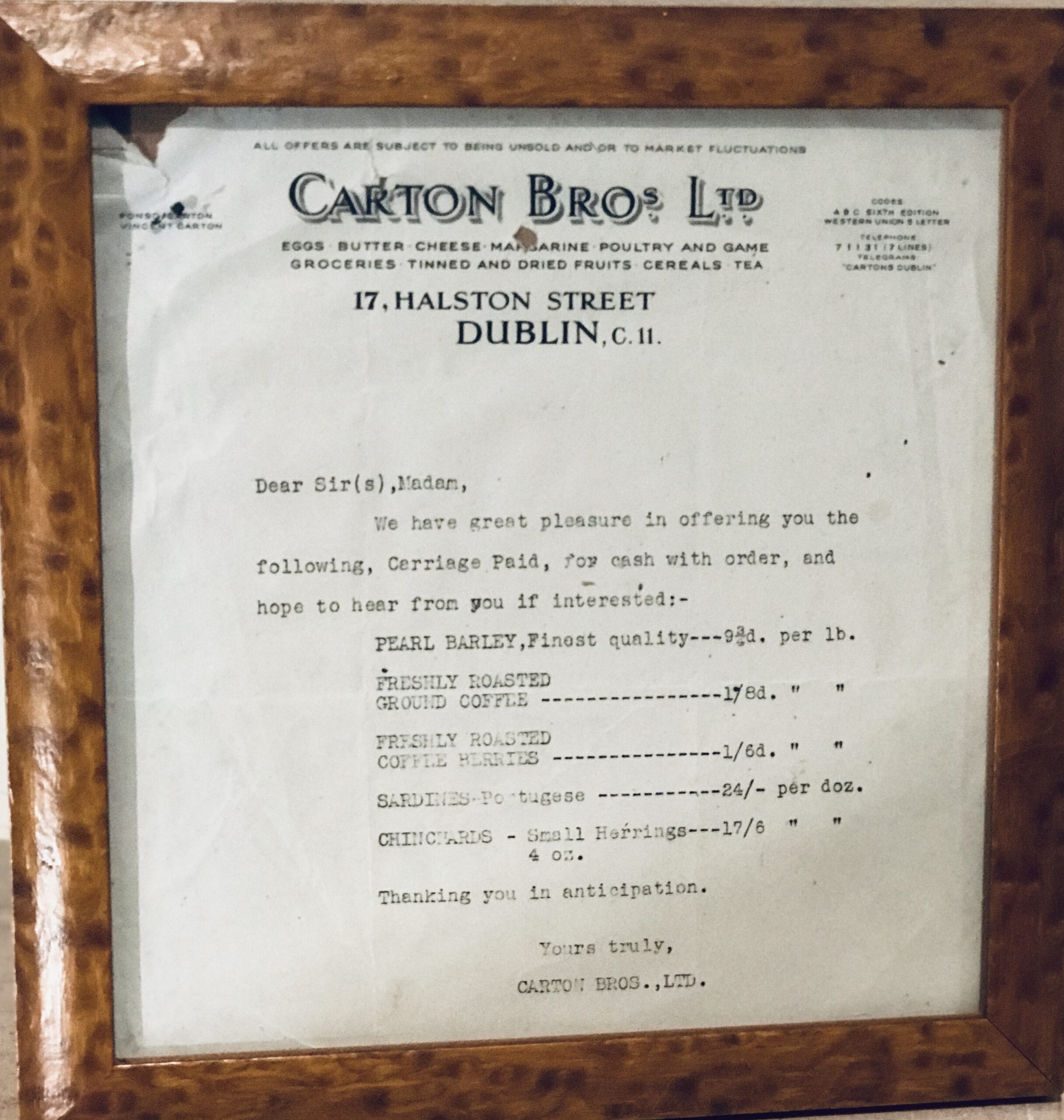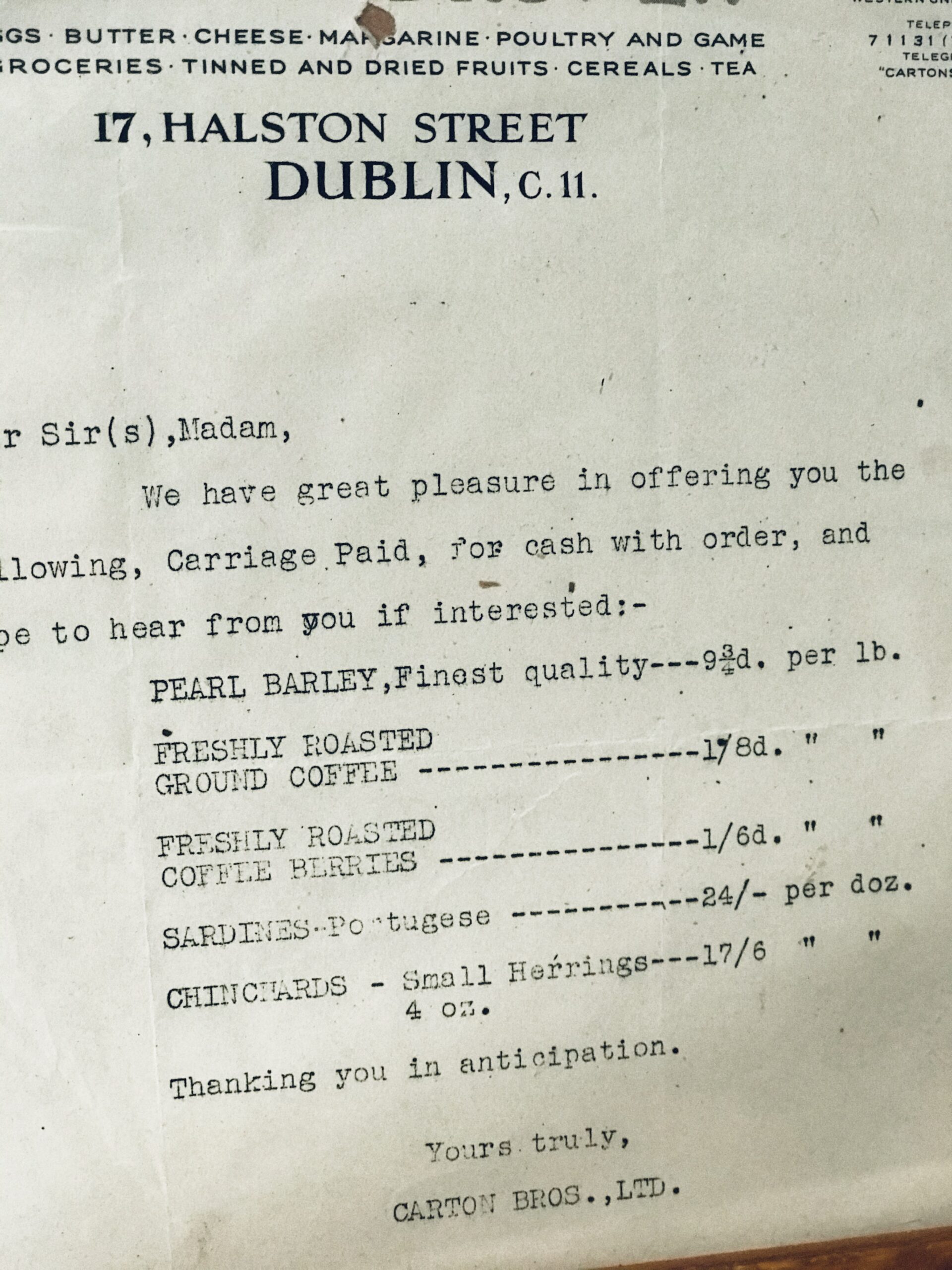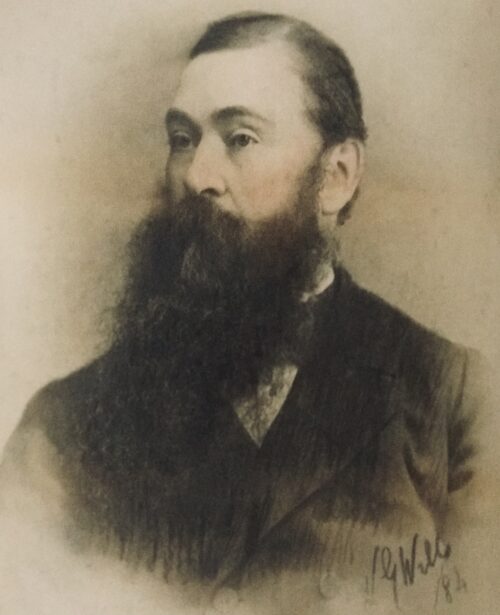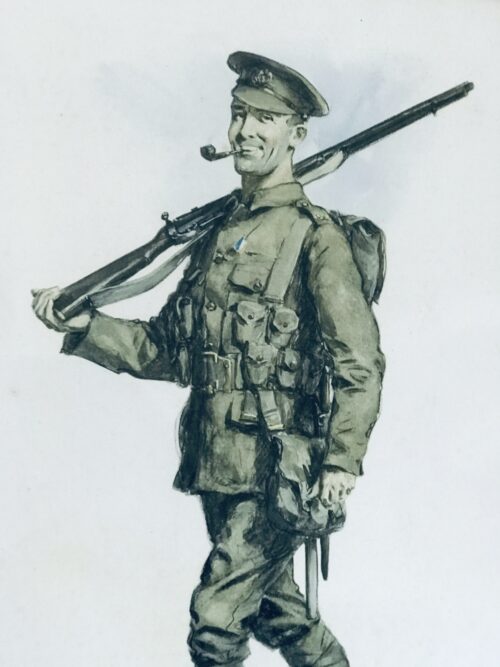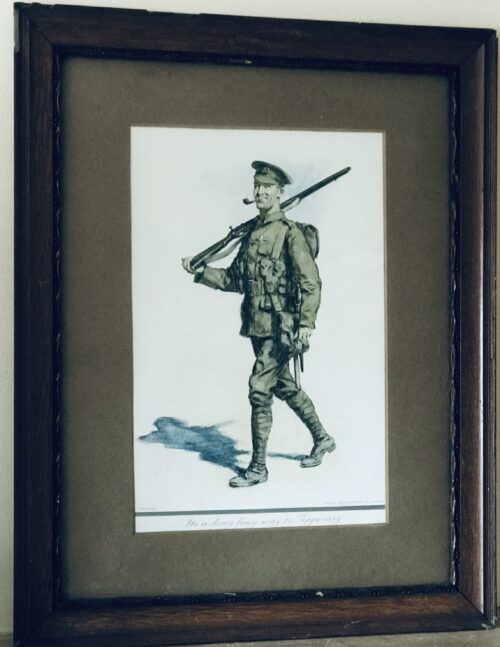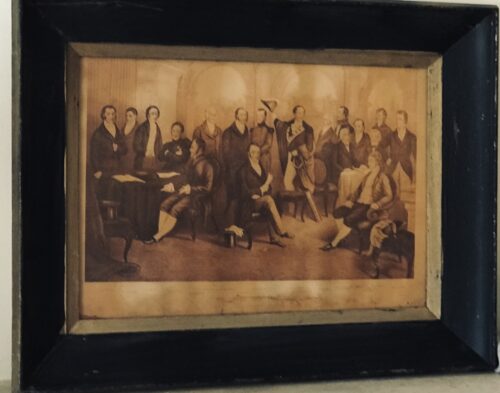Original 1940s Invoice from Carton Bros Dublin who were general grocery wholesalers.These unique artefacts of old Irish commercial life will make superb decorative item for any discerning Irish pub or home bar with a distinctive Irish theme.What makes these items of even more historical value and interest is the fact that the majority of them date from the World War 2 Era or what was known as the Emergency in Ireland as its remained somewhat controversially neutral under DeValera’s leadership.We can see vividly through these unique items how ordinary people and both small and large businesses alike were presented with an unprecedented set of challenges -rationing,increaseed regulation and of decreased supply and increased demand created by a world in turmoil.
Presented in antique frames, these are the real deal after a number were found in an old suitcase bought at auction. If interested in buying a number of these charming pieces of Irish commercial ephemera, please contact us directly at irishpubemporiu@gmail.com for a special deal !
Dingle Co Kerry 27 cm x 23cm
A short history of Ireland during the Second World War, by John Dorney.
The Second World War was the defining event of the twentieth century. It saw, as well as the deaths of tens of millions and devastation of two continents, the defeat of Hitler and Nazism, the decline of the once dominant European empires and the rise to superpower status of the United State and the Soviet Union.
In the Irish state, popularly known throughout the war years as ‘Eire’ it was also a crucial event, though more for what did not happen than what did.
Ireland did not join the war, but declared neutrality. Indeed the world war, in Ireland, was not referred to as a war at all, but as ‘The Emergency’.
In staying neutral, despite British and latterly American pleas to join the war, Ireland, under Eamon de Valera, successfully asserted the independence of the new state.
However, Irish neutrality was a fraught affair – a delicate balancing act between neutrality and secretly aiding the Allied powers.
Background, incomplete independence
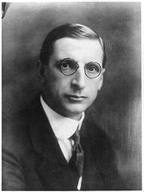
The independence struggle of 1916-1921 had not resulted, as Irish Republicans had dreamed, in a fully independent all-Ireland Republic.
Instead, the Treaty settlement of 1921 left two states in Ireland. One, the Irish Free State, in 26 of Ireland’s 32 counties was a self-governing dominion of the British Empire. The other 6 counties, Northern Ireland, was a unionist dominated autonomous region of the United Kingdom.
While the Free State was much more independent than Northern Ireland, it was not completely so. As well as symbolic ties to Britain – an oath of fidelity members of parliament had to take to the British monarch and Governor General who represented the King as head of state in Ireland, the British retained three naval bases around the Irish coast, at Cobh, Bearhaven and Lough Swilly.
The acceptance of this settlement tore the unity of the Irish nationalist movement apart, in a bitter Civil War in 1922-23, won by the pro-Treaty faction.
The Irish state stayed neutral during the War to assert its independence from Britain.
The anti-Treaty Republicans never fully accepted their defeat however. What was left of the guerrilla army that had fought British and the Civil War, the IRA, never accepted the Free State. In 1932, the major political party that emerged from the anti-Treaty movement, Fianna Fail, came to power by election.
Under Eamon de Valera, they set about dismantling the Treaty, abolishing the oath to the British monarchy, the Governor General and the Senate and introducing a new constitution in 1937. They also initiated a tariff war with Britain by refusing to pay back the Land Annuities that Britain had granted to subsidise land reform in Ireland in the early twentieth century.
While this satisfied many of de Valera’s supporters, the IRA continued to oppose anything short of a fully independent Irish Republic. De Valera had legalised the organisation in 1933, but he banned them again in 1936, as they would not give up their arms or illegal methods.
De Valera’s new constitution removed the name Irish Free State and stated that the country’s name was ‘Eire, or in the English language Ireland’. The name ‘Eire’ stuck abroad to distinguish the former Free State from Northern Ireland.
By 1938, however, both de Valera and the British government of Neville Chamberlain, were eager to normalise relations with each other. De Valera agreed to pay a lump sum towards the land annuities and in return, Chamberlain lift the onerous tariffs on Irish agricultural imports.
Most importantly though, the British agreed to return to Ireland the three ‘Treaty ports’ on the Atlantic Coast.
The British analysis was that the ports had not been well-maintained, required investment and would be difficult to defend in wartime should the Irish ever try to take them back. But the British thought they were being returned to Ireland on the implicit understanding that British naval forces would be allowed to use them in the event of a European war.
De Valera, on the other hand, had insisted that the return of the ports be unconditional and when war broke out, refused the British request to use the ports as anti-submarine bases.
The Treaty ports and Irish unity
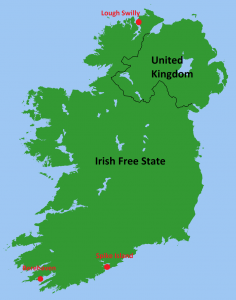
Nazi Germany invaded Poland in September 1939, causing Britain and France to declare war on Germany. Ireland immediately declared neutrality.
By the summer of 1940, however the situation had changed dramatically and to the peril of neutral Ireland.
German forces had rolled over most of western Europe, occupying Denmark, Norway the Netherlands, Belgium and most importantly, France. The British Army had only barely escaped annihilation at Dunkirk.
Britain now faced a fight for its life, with the Atlantic Ocean and trade with America as it last lifeline. Now it again desperately needed the use of Atlantic Ports that it had returned to Ireland in 1938, to safeguard the convoys of merchant ships that crossed the Atlantic with food and arms.
Winston Churchill had to be persuaded not to invade Ireland to take Ireland’s Atlantic ports.
At this point Neville Chamberlain was replaced as British Prime Minister by Winston Churchill, who took a far less conciliatory position on Irish neutrality than his predecessor.
Churchill was one of the architects of the Anglo-Irish Treaty back in 1921 and considered that the Irish state only existed as agreed under the Treaty, ‘under the [British] Crown’. He therefore considered Irish neutrality as a breach of the Treaty and that Britain would be within its rights to re-occupy the territory of the Irish Free State.
On numerous occasions he had to be talked out of unilaterally taking back the ‘Treaty Ports’ in Ireland by military action by his cabinet
Churchill however also attempted to lure de Valera into the war by offering him the prospect of Irish unity in return for an end to the policy of neutrality. In popular consciousness this is often held to have been confined to a late night note Churchill fired off to de Valera in which he wrote ‘now or never, a nation once again’.
In reality however, the British offer of a united Ireland was far more concrete than is widely understood. Irish and British teams negotiated for months, and the British under Neville Chamberlian offered de Valera of formal offer of unity on June 28 1940, in return for British troops, planes and ships being allowed to garrison the Treaty Ports.
What decided de Valera against accepting the offer, apart from the innate fears of entering the war, was that a prospective united Ireland would have to be approved in the Northern Ireland Parliament. As long as this was dominated by unionists, this meant that no British offer of unity was likely to come to pass. Ireland and her ports stayed out of the war.
Northern unionists, meanwhile, were outraged at the prospect of a united Ireland negotiated behind their backs between London and Dublin.
Neutral?
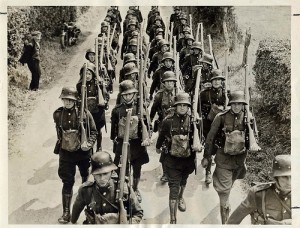
Because of Ireland’s stance, many in Britain claimed that Ireland was secretly pro-Axis and rumours, mostly unfounded, abounded of German u-boats docking on Ireland’s west coast.
Pressure increased on Ireland to join the war after the entry of the United State in 1941. The American consul in Dublin David Gray, was extremely hostile to Irish neutrality and consistently reported, erroneously, that Irish neutrality was pro-Axis.
This meant that Ireland had to aid the Allies in order placate Britain, avoid a possible British invasion and to avoid American hostility. At the start of the war, De Valera secretly agreed with the British to share naval and marine intelligence with them.
Dan Bryan, the head of Irish military intelligence, developed particularly close relations with his British counterparts during the war.
The standard practice for neutral countries was to intern any belligerent personnel who landed there. At the start of the war, Ireland followed this practice and detained both Allied and German airmen who crash landed in Ireland.
Despite its neutrality, in practice Ireland aided the Allies in many ways.
However, in 1943, Ireland quietly released all its 33 Allied internees while keeping the Germans incarcerated. About 260 German military, air force and naval personnel, who had mostly crashed landed in Ireland, were interned in Ireland during the war
From this point onwards, when allied airplanes crashed in Irish territory, their surviving crews were secretly escorted across the border, back into British territory. And where possible, their machines were also repaired and returned. The official justification for this was that all allied planes over Ireland were on training missions, whereas the Germans were on combat missions.
From 1941 onwards, Ireland also permitted allied planes to fly over Irish air space in an ‘air corridor’ over County Donegal into Northern Ireland. In 1944, in the run up to the Normandy Landings in France, Irish weather stations provided the allies with secret weather reports that helped the invasion of Europe to go ahead
Northern Ireland, meanwhile, became a major staging post for the United State military, with a naval and Marine Corps base in Derry and thousands of American military personal, including five Army divisions, garrisoned there ahead of the invasion of Europe.
The role of the IRA
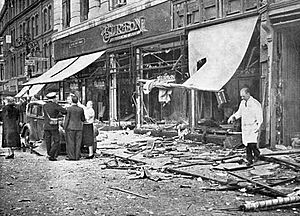
One of the major headaches for those trying to safeguard Irish neutrality was the IRA, which was determined to get German military aid to overthrow both states in Ireland, north and south.
As well as defying Irish law, the IRA’s actions threatened to undermine Ireland’s neutrality in the war and bring about a confrontation with Britain.
IRA Chief of Staff Sean Russell tried to make contact with the Germans as early as 1936 and IRA leader Tom Barry was brought to Germany as a guest of German intelligence in 1937 and asked about the possibility of the IRA carrying out sabotage against Britain in the event of war.
The IRA sought German aid during the War but was harshly repressed on both sides of the border.
In 1939, starting before war broke out between Britain and Germany, Russell launched a bombing campaign in England, targeting power stations and factories but also cinemas and post offices. The logic of Russell’s campaign was that while Britain was engaged in a world war it might be forced to leave Northern Ireland in order to stop the bombing campaign at home.
Seven English civilians were killed in the bombing campaign. The most dramatic event was a bomb in attack in Coventry that killed five people, for which two IRA members were later hanged.
In Ireland the IRA was also involved in intermittent anti-state activities. In December 1939 they stole one million rounds of ammunition from the Irish Army’s depot at the Magazine Fort in Dublin’s Phoenix Park. They also bombed Garda (police) headquarters at Dublin Castle and shot a number of Garda detectives in various incidents, killing five detectives over the course of the war
In response, the de Valera government interned over 500 IRA members at the Curragh and jailed another 100 for the duration of the war. The Irish government also executed six IRA members between 1940 and 1944 for shooting Gardai or soldiers.
In Northern Ireland, the IRA carried out some attacks from 1942 onwards, killing over the course of the war, six RUC policemen. There too, internment was introduced, 300 IRA men were imprisoned and one IRA man, Tom Williams, was hanged by the Northern government for the killing of an RUC constable in 1942.
German and IRA collaboration
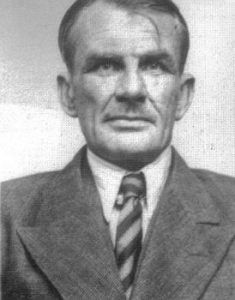
There was an on-off partnership between the IRA and German military intelligence during the war.
Essentially the Germans wanted two things from Ireland during the Second World War. The first and most important was that Eire would remain neutral and deny the British use of the Treaty Ports on Ireland’s western coast.
Because of this they discouraged the IRA from attacks south of the border.
Their secondary objective and reason for cooperating with the IRA, was to foment a rebellion by nationalists in Northern Ireland to divert British resources from war fronts elsewhere.
In 1940 the Germans also considered invading the south coast of Ireland, in plan known as Operation Green. This would have been intended as a diversionary attack during an invasion of Britain itself. However this never got beyond the planning stage.
Alternatively if the British invaded Eire in order to take the Atlantic ports, Hitler thought that de Valera might ask for German assistance, in which case Germany would invade in support of Irish forces. In fact, while de Valera rebuffed the offers of military aid from the German ambassador Hempel, he did make a working agreement to invite British troops into Ireland in the event of a German invasion.
The Germans wanted to use the IRA to launch an insurrection in Northern Ireland.
Sean Russell, the IRA leader who had pioneered cooperation with Nazi Germany, died of a burst ulcer aboard a u-boat on his way back to Ireland in August 1940. However this was far from the end of the IRA‘s contacts with German intelligence.
The Germans landed over dozen agents in Ireland during the war, the most important of whom was Hermann Goertz, a military intelligence officer, whose job it was to liaise with the IRA.
Stephen Hayes, the IRA Chief of Staff, had a plan drawn up ‘Plan Kathleen’ for a German invasion of Northern Ireland, involving a landing in Derry, which the IRA would have supported through an attack over the border from County Leitrim.
Goertz discussed the plan with Stephen Hayes but was not impressed either with Hayes, the IRA’s capabilities or with the details of the plan.
In fact, the German agent concluded that the IRA was all but useless to German war aims and instead began trying to create a network of informants based on far-right wing sympathisers such as Niall MacNeill, an Irish Army intelligence officer and former Blueshirt leader Eoin O’Duffy
After 18 months in Ireland, Goertz was arrested in November 1941, more or less ending the overt collaboration of the IRA with Nazi Germany.
Despite the Germans’ on-off dealings with the IRA, the Eamon de Valera and the Irish government generally had a cordial relationship with the German ambassador, Eduard Hempel, who was regarded as dealing more respectfully with neutral Ireland than did the British or American representatives in Dublin.
For this reason de Valera consistently refused Allied demands that the German ambassador be expelled.
Bombing
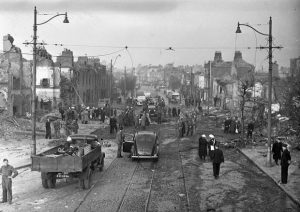
One of the main reasons for Irish neutrality, apart from the demonstration of independence from Britain it allowed, was that the country would be defenceless against aerial bombing.
And certainly the southern state was spared the fate of Northern Ireland during the war. Belfast in particular was systematically targeted by German bombers in April and May 1941 due to its possession of shipyards and war industries.
During the ‘Belfast Blitz’ – consisting of three large air raids – over 1,000 people were killed and thousands more injured and made homeless.
Dublin was bombed accidentally but Belfast was systematically bombed and over 1,000 civilians were killed.
Southern fire engines were sent north to aid the Northern authorities in the aftermath of the bombings.
While it did not see concerted bombing of that kind, on a number of occasions, the 26 county Irish state was indeed bombed by the Germans, most notably the North Strand area of Dublin in May 1941, in which 28 people were killed. The Germans later apologised for the bombing and paid compensation
While it has been speculated that such bombings were a veiled threat from the Germans as to what would happen if Ireland abandoned neutrality, historian Michael Kennedy judges that they were in fact the result of German bombers dumping their bombs on return flights from unsuccessful mission in Northern Ireland
End of the War
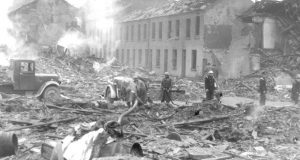
Germany surrendered to the Allies on May 8 1945 after Adolf Hitler’s suicide. Very controversially, Eamon de Valera paid a courtesy visit to the German ambassador Hempel’s residence to offer his condolences on the death of the Nazi leader.
De Valera maintained that he was merely observing the standard diplomatic protocols on the death of a foreign head of state.
Ireland survived the war more or less unscathed. Strict rationing had to be applied and there were severe shortages of items such as coal and petrol during the war years. Still, this was insignificant compared to the devastation that had been wrought in much of the rest of Europe.
However its neutral stance during the war left it somewhat isolated in the immediate postwar years.
For instance, while other western European countries received free American aid under the Marshall Plan in the 1940s, the Americans queried why neutral Ireland either deserved or needed such aid. In the end Ireland got a loan of £36 million
The sharp contrast between the experience of the war north and south of the border also tended to reinforce the partition of Ireland in the coming decades.

